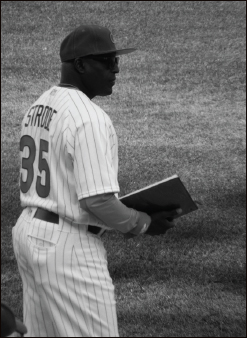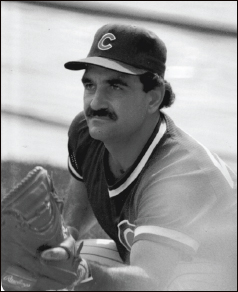
#35: HI, HY, BUDDY, BO AND TURK
| ALL-TIME #35 ROSTER: | |
| Player | Years |
| Lennie Merullo | 1941–42 |
| Hi Bithorn | 1943 |
| Hy Vandenberg | 1944–45 |
| Marv Rickert | 1946–47 |
| Ralph Hamner | 1947–49 |
| Turk Lown | 1951–54 |
| Vicente Amor | 1955 |
| Rogers Hornsby (coach) | 1958–59 |
| Morrie Steevens | 1962 |
| Mike Paul | 1973–74 |
| Buddy Schultz | 1975–76 |
| Woodie Fryman | 1978 |
| Doug Capilla | 1979–81 |
| Jon Perlman | 1985 |
| Larry Cox (coach) | 1988–89 |
| Chuck McElroy | 1991–93 |
| Willie Banks | 1994 |
| Bob Patterson | 1996–98 |
| Felix Heredia | 1998 |
| Bo Porter | 1999 |
| Danny Young | 2000 |
| Brant Brown | 2000 |
| Scott Downs | 2000 |
| Will Ohman | 2000–01 |
| Alan Benes | 2002–03 |
| Randall Simon | 2003 |
| Chris Speier (coach) | 2005–06 |
| Lester Strode (coach) | 2007–15 |
It says a lot about a number when the best Cub to wear it was a coach. The great Rogers Hornsby wore #35 in 1958–59, returning to the Cubs more than a quarter century after being canned as player-manager (while wearing #9). In fact, #35 has endured so much mediocrity, Chris Speier, a .246-hitting three-time All-Star shortstop with the 1970s Giants, a reserve with the mid-1980s Cubs (wearing #28), and a coach for the last two years of the Dusty Baker regime as #35, is the most recognizable name on this list next to Rajah’s.
Lester Strode (2007–15) has kept the number under wraps in the bullpen for a while—almost always seen in a pullover as opposed to a uniform. Larry Cox, who served as Cubs catcher and later bullpen coach (1988–89) was popular and outgoing, but too short for this earth. He died at age forty-two after playing racquetball with his son just a few months after the Cubs celebrated what would be their last NL East title.

Read all about it! Bullpen coach Lester Strode shows his number and not his jacket on Mother's Day, 2016.
No Cubs player has worn #35 for more than four seasons, and that wearer, Turk Lown (1951–54), last wore it more than fifty years ago. Lown pitched his first six seasons in a Cubs uniform, the first four of them wearing #35. After being a less-than effective spot starter (16–27, 4.96) his first three years, Lown spent part of ’54 in the bullpen. After spending 1955 in the Pacific Coast League (going 12–5), Lown returned to Chicago in ’56 wearing #31. He had two effective seasons as a reliever, recording 13 saves in ’56 and 12 in ’57, which would have ranked third both years in the NL had saves been invented then (they weren’t until 1960; save totals before then have been retroactively calculated). Naturally, Lown’s success got him traded away from the Cubs. He was sent to the Reds for Hersh Freeman, who pitched nine games for the Cubs before leaving baseball. Lown, meanwhile, helped lead the White Sox into the 1959 World Series, leading the AL with 15 saves.

Cubs catcher Larry Cox spent far too short a time in #35 as bullpen coach. He died in 1990 at age forty-two.
And apart from that, #35 has been most well-known for the odd, cute, or funny names that its wearers owned. Hi Bithorn, who also wore #17 and #25, was the first major leaguer born in Puerto Rico; Hy Vandenberg (1944–45) was an effective spot starter (7–3, 3.49) for the ’45 NL champs; Buddy Schultz (1975–76), no relation to ex-Cub Barney Schultz, put up a 6.14 ERA in 35 Cubs appearances and eventually wound up with Barney’s old team, the Cardinals; and Bo Porter, who went 5-for-26 for the 1999 Cubs, and has served as third-base coach for four major league teams, plus managing the Astros their first two bumpy seasons as an American League convert.
Thirty-five minutes seems like the length of stay of many wearers of #35. Jon Perlman, the Cubs’ first draft pick in 1979, spent six years in the minors and six games in a Cubs uniform, posting an 11.42 ERA before being released. Willie Banks had a good year for the Twins in 1993, so naturally, that got Cubs management interested in dealing for him. He went 8–12, 5.40 for the Cubs in 1994 and switched to #27 in 1995. He is the second-best Banks in Cubs history.
And in 2000, four players wore #35, though none of them memorably. Danny Young, a left-hander who threw hard, made the team by having a good spring training largely because the Cubs were permitted to have an expanded roster for their Opening Day trip to Japan. Young threw three innings, walked six and struck out none and was gone by April 6. He is one of the lowest-round draft picks ever to make the majors, originally drafted in the eighty-third round by the Astros in 1991. In June 2000, Brant Brown was reacquired by the Cubs in a three-way trade and donned #35 for a three-game series vs. the White Sox at the Cell because his former number, 37, was then being worn by Scott Downs. When the Cubs returned home from their road trip to the South Side, Brown and Downs swapped shirts and Downs became the third player to wear #35 in the 97-loss 2000 season. Downs wore it for only seven starts before being traded to Montreal for Rondell White on July 31. Two weeks later it was donned by Will Ohman, but it would be five years before the southpaw stuck in the bigs and started racking up appearances like he would uniform numbers (#45, #50, #13).
The most fun anyone had in #35 must have been had by Randall Simon (2003). Acquired from the Pirates only a few weeks after a well-publicized incident in which he had “attacked” one of the Miller Park Racing Sausages in Milwaukee with his bat (he had meant it as a playful gesture, but the young woman playing the hot dog, Mandy Block, did fall over), Simon later autographed the bat for Block and, when returning to Milwaukee later that season as a member of the Cubs, bought Italian sausages for an entire section of the ballpark (many of them Cubs fans). Simon hit six homers in 33 games for the Cubs and batted .333 in 24 postseason at-bats, but when the Cubs traded for Derrek Lee before the 2004 season, Simon, who could only play first base, was jettisoned like a burnt brat.
MOST OBSCURE CUB TO WEAR #35: Vicente Amor (1955). Cubs fans didn’t have very much time to “amor”—Spanish for “love”—the Cuban native, who had been acquired the previous offseason from the Oakland Oaks of the Pacific Coast League. He appeared in four games, pitching six innings and allowing three earned runs, and was then sent back to the minors. Two years later, he pitched in nine games for the Reds before vanishing from the majors forever.
GUY YOU NEVER THOUGHT OF AS A CUB WHO WORE #35: Woodie Fryman (1978). In a rather pointless exchange, Fryman, who had won 110 games in twelve seasons for the Phillies, Pirates, Tigers, Expos, and Reds, was acquired on October 31, 1977 from Cincinnati in return for Bill Bonham, a hard-throwing right-hander who was supposed to be the Next Big Thing for the Cubs rotation. Bonham managed to last three years in Cincinnati before arm troubles forced him to retire at age thirty-one, but Fryman, who was already thirty-seven when the Cubs acquired him, lasted only two months in Chicago, going 2–4, 5.17 before being traded back to one of his former teams, the Expos, on June 9 for a player to be named later. The player later named on July 23 turned out to be Jerry White, who made one of the greatest catches in Wrigley Field history on August 2 against the Cardinals: a laid-out, diving grab that helped preserve a 3–2 win. Fryman, meanwhile, pitched effectively for Montreal for several more seasons including their lone playoff year in 1981, and White was also sent back to Canada, where he spent several years as a backup outfielder.
Strikeouts by the Bushel
With Fergie Jenkins as the all-time Cubs strikeout leader (2,038) and fellow #31 Greg Maddux fifth on the all-times Cubs rolls at 1,305, it only makes sense that the number leads all others in the art of fanning. With clubhouse manager Yosh Kawano favoring numbers in the thirties for pitchers, it’s no wonder that the thirties dominate the list, with #35 the lone exception in the top twenty (it’s a contact number, so to speak, with plenty of hitters mixed in with soft-throwing pitchers). Seven numbershave reached the 3,000-K plateau. It had been all numbers in the thirties until Ryan Dempster (#46) and Carlos Marmol and Jake Arrieta (#49) crashed the party.
| Number | Strikeouts (SO) |
| 31 | 5,071 |
| 46 | 3,751 |
| 30 | 3,687 |
| 36 | 3,659 |
| 49 | 3,506 |
| 32 | 3,402 |
| 34 | 3,335 |
| 37 | 2,862 |
| 38 | 2,818 |
| 40 | 2,726 |
| 33 | 2,502 |
| 48 | 2,411 |
| 17 | 2,042 |
| 39 | 1,956 |
| 22 | 1,804 |
| 45 | 1,713 |
| 43 | 1,661 |
| 44 | 1,553 |
| 18 | 1,440 |
| 47 | 1,364 |